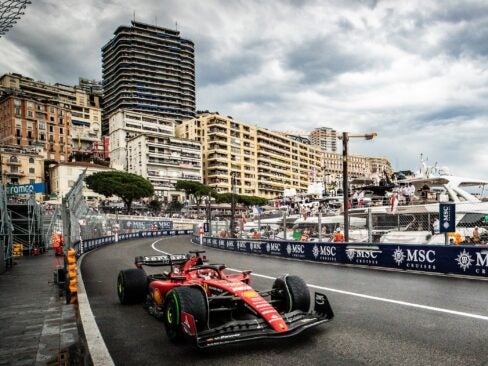Travel to historic cities across Spain for insight into the diverse cultural influence that’s made this the country it is today. The most majestic monuments in Spain tell the stories of this fascinating past through their architectural magnificence.
Alhambra Palace, Granada
One of Spain’s most iconic monuments, this palace and fortress is what brings many travelers to the Andalusian city. The Unesco World Heritage architectural complex, which sits on a plateau overlooking the city, is an impressive sight on the skyline and an example of this country’s diverse cultural influences, giving insight into its history. While much of the structure was built in the mid-13th century — completed in the mid-14th century by Muhammed V, Sultan of Granada — the original fortress dates back as far as AD 889. From the Royal Complex and Court of the Myrtles to the mesmerizing halls, explore the sprawling grounds and step inside its ancient rooms and courtyards to see intricate decoration of Arabic inscriptions, artwork and mosaic, as well as points of interest like the Fountain of Lions. Visit the Alhambra Museum on the south wing of the palace to make the experience even more enriching.
Image: Instagram @alhambra_oficial
The Mosque-Cathedral of Cordoba
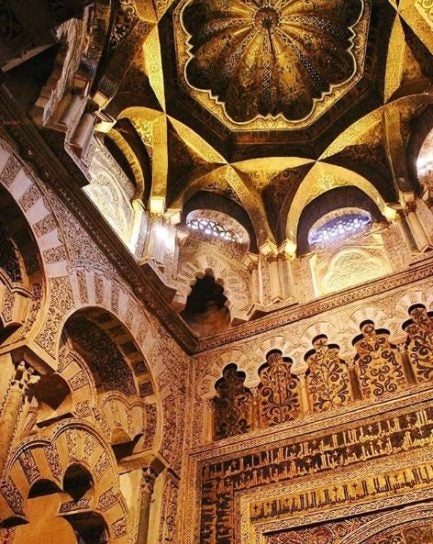 Another of Andalusia’s great landmarks, the Mezquita (mosque) of Cordoba, which is also known as Cordoba Cathedral in its role as a Catholic church, is a reminder of Cordoba’s time as one of Europe’s most prosperous cities in science, culture and the arts. Enter through the Patio de los Naranjos to find yourself amid the mosque’s arches with striking red and white design and over 850 granite and marble pillars where light streams in from the four cupolas, adding even more atmosphere. This mosque dates back to the 10th century, but the Renaissance cathedral which lies at the heart of this enclave, was created in the early 16th century. Both the architecture and artwork in the cathedral are representative of Cordoba’s artistic legacy. With such a contrast in architectural styles and encompassing different chapters of history, this is an absorbing site to explore. Climb the steps of the bell tower for views over the city.
Another of Andalusia’s great landmarks, the Mezquita (mosque) of Cordoba, which is also known as Cordoba Cathedral in its role as a Catholic church, is a reminder of Cordoba’s time as one of Europe’s most prosperous cities in science, culture and the arts. Enter through the Patio de los Naranjos to find yourself amid the mosque’s arches with striking red and white design and over 850 granite and marble pillars where light streams in from the four cupolas, adding even more atmosphere. This mosque dates back to the 10th century, but the Renaissance cathedral which lies at the heart of this enclave, was created in the early 16th century. Both the architecture and artwork in the cathedral are representative of Cordoba’s artistic legacy. With such a contrast in architectural styles and encompassing different chapters of history, this is an absorbing site to explore. Climb the steps of the bell tower for views over the city.
Image: Instagram @viveandalucia
La Sagrada Familia, Barcelona
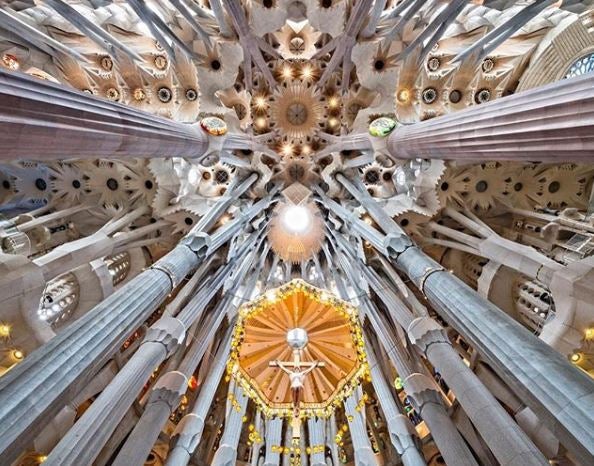 Immediately recognizable for its distinct architecture, this Antoni Gaudi-designed Roman Catholic cathedral is one of Barcelona’s best known sites and one that’s famously been under construction since it was founded in 1882 — completion is expected for 2026. This alone makes the landmark a great point of interest, but the structure is also remarkably striking with its unique spires and the Basilica’s spellbinding vaulted Crossing room decorated with Venetian glass. Visits can include guided tours and access to one of the towers. Combine your visit to La Sagrada Familia with a look around the Gaudi House Museum, which opened in 1963 to show who Gaudi was aside from being the architect we all know.
Immediately recognizable for its distinct architecture, this Antoni Gaudi-designed Roman Catholic cathedral is one of Barcelona’s best known sites and one that’s famously been under construction since it was founded in 1882 — completion is expected for 2026. This alone makes the landmark a great point of interest, but the structure is also remarkably striking with its unique spires and the Basilica’s spellbinding vaulted Crossing room decorated with Venetian glass. Visits can include guided tours and access to one of the towers. Combine your visit to La Sagrada Familia with a look around the Gaudi House Museum, which opened in 1963 to show who Gaudi was aside from being the architect we all know.
Image: Instagram @basilicasagradafamilia
Cathedral of Santiago de Compostela
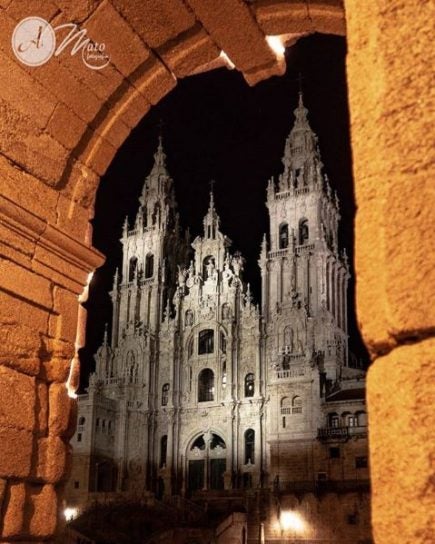 Santiago de Compostela is a city of great significance to many people around the world. It’s the culmination of the Camino de Santiago pilgrimage and it’s said to be the burial site of Biblical apostle, Saint James. The Cathedral of Santiago de Compostela is where his remains are believed to be. Construction began on this Romanesque cathedral in 1075 but it wasn’t until 1211 that the Basilica was consecrated. Now you can see this structure’s medieval origins fused with additions made to the building during the Renaissance, Baroque and Neoclassical periods, to name a few. All of this results in the elaborately decorated and imposing building you now see positioned on Santiago de Compostela’s main square. The cathedral has a museum too, telling visitors about the site’s history and art.
Santiago de Compostela is a city of great significance to many people around the world. It’s the culmination of the Camino de Santiago pilgrimage and it’s said to be the burial site of Biblical apostle, Saint James. The Cathedral of Santiago de Compostela is where his remains are believed to be. Construction began on this Romanesque cathedral in 1075 but it wasn’t until 1211 that the Basilica was consecrated. Now you can see this structure’s medieval origins fused with additions made to the building during the Renaissance, Baroque and Neoclassical periods, to name a few. All of this results in the elaborately decorated and imposing building you now see positioned on Santiago de Compostela’s main square. The cathedral has a museum too, telling visitors about the site’s history and art.
Image: Instagram @santiagoturismo
Cathedral of Seville
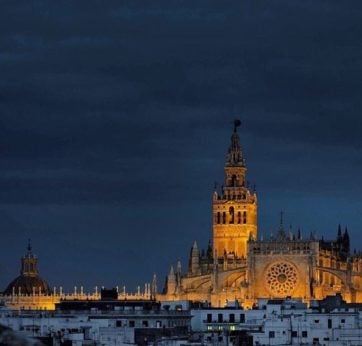 When construction of this Roman Catholic cathedral came to completion in the early 16th century it became the biggest cathedral in the world. Covering an impressive 124,000 sq ft, it’s still the largest Gothic church in the world. The cathedral was built to represent the city’s prosperity with its construction taking more than a century to complete. While the consecration of this cathedral didn’t take place until 1507, the story of this site goes back much further. The cathedral’s bell tower was originally erected as a minaret in the late 12th century, with the Renaissance-style top then added by the Spanish conquistadors in the 16th century. As you’d expect, the building is resplendent in ornate detail, both inside and out, with a number of particular points of interest. The cathedral houses the tomb of Christopher Columbus, and the northeast corner contains the domed Royal Chapel.
When construction of this Roman Catholic cathedral came to completion in the early 16th century it became the biggest cathedral in the world. Covering an impressive 124,000 sq ft, it’s still the largest Gothic church in the world. The cathedral was built to represent the city’s prosperity with its construction taking more than a century to complete. While the consecration of this cathedral didn’t take place until 1507, the story of this site goes back much further. The cathedral’s bell tower was originally erected as a minaret in the late 12th century, with the Renaissance-style top then added by the Spanish conquistadors in the 16th century. As you’d expect, the building is resplendent in ornate detail, both inside and out, with a number of particular points of interest. The cathedral houses the tomb of Christopher Columbus, and the northeast corner contains the domed Royal Chapel.
catedraldesevilla.es
Image: Instagram @disfrutasevilla
The Alcázar of Segovia
 This Unesco World Heritage fortress rises dramatically from the rocky outcrop where two rivers meet in the city of Segovia, with an architectural style that immediately likens it to a fairy tale palace. Originally built as a fortress but later used as a royal palace, state prison and military academy, it has been the setting for centuries of fascinating history with a series of distinct eras going back to the 12th century. The castle now acts solely as a museum, giving insight into its significant history. Wander between the exterior’s courtyard, moat, drawbridge and keep, and the interior’s chapel, Armory Museum and noble rooms, then climb the Tower of Juan II for far reaching views over Segovia.
This Unesco World Heritage fortress rises dramatically from the rocky outcrop where two rivers meet in the city of Segovia, with an architectural style that immediately likens it to a fairy tale palace. Originally built as a fortress but later used as a royal palace, state prison and military academy, it has been the setting for centuries of fascinating history with a series of distinct eras going back to the 12th century. The castle now acts solely as a museum, giving insight into its significant history. Wander between the exterior’s courtyard, moat, drawbridge and keep, and the interior’s chapel, Armory Museum and noble rooms, then climb the Tower of Juan II for far reaching views over Segovia.
Image: Facebook Alcázar de Segovia







